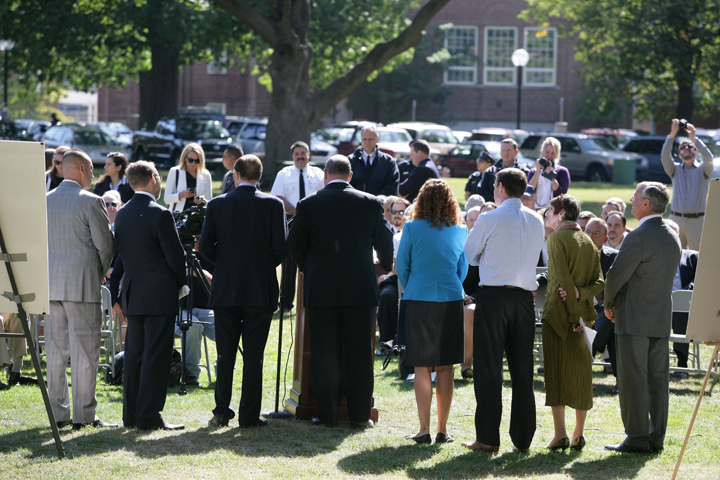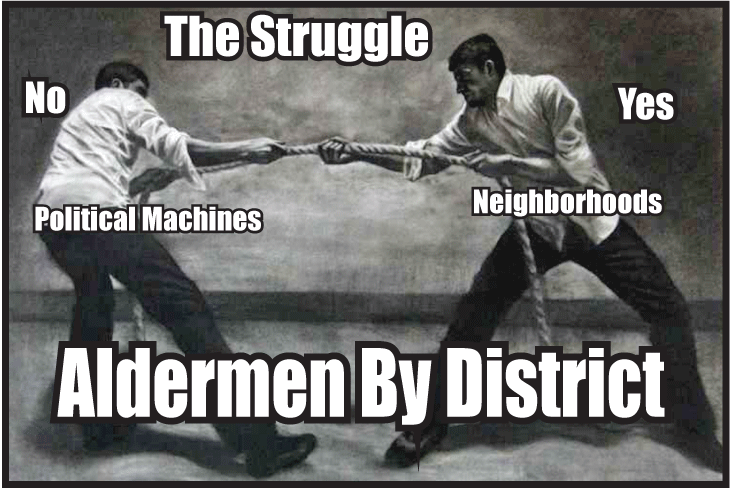Commentary By John Murray
In the past four months Waterbury Mayor Neil O’Leary has been successful in leveraging his influence on the local political scene to help secure $35 million dollars in state and federal aid. This November voters in Waterbury will be asked if they want to elect aldermen by district, or whether to keep the current at-large system in place. The idea of electing aldermen by district has been kicked around since 1994, and while much of the debate has been defined by ethnicity and skin color, it really is an issue of fairness and equal representation.
Let’s explore how O’Leary secured the funding, and examine how we might use this example to get at the heart of why aldermen by district might be the only way to pry control away from the political parties in the city, and return power to the neighborhoods, and to the people.
Mayor O’Leary was able to successfully land millions in federal and state grants and loans, but he didn’t do it alone. O’Leary relied on close relationships with two U.S. Senators, two Congresswomen, the Governor and the state delegation to get the job done.

Waterbury Mayor Neil O’Leary announced the TIGER Grant in Library Park.
When he stood in Library Park in September to announce the TIGER grant the mayor was effusive in his praise for four federal elected officials: two U.S. Senators, Richard Blumenthal and Chris Murphy, and two Congresswomen, Elizabeth Esty and Rosa DeLauro.
What all four have in common is that they represent a geographical district. The Senators represent Connecticut, and the Congresswomen each represent 1/5th of Connecticut. O’Leary needed help in securing funds to move the city forward and didn’t lobby a U.S. Senator from Wyoming, or a Congressman from Alaska. O’Leary put the squeeze on politicians who represent the interests of Waterbury, and they applied pressure in Washington D.C. to secure the funds.
During a recent interview I asked the mayor if the federal TIGER grant would have been possible without close political ties to the federal politicians.
“It would have been very difficult,” O’Leary said.
Imagine a scenario where all 100 U.S. Senators were elected at-large, and each represented the entire United States. Where do you suppose those senators would come from? Here’s my guess: 25 from California, 18 from Texas, 20 from Florida, 15 from Ohio and 14 from Pennsylvania. That would be 92 senators from five states, leaving eight additional seats to be divided up by the other 45 states. Do you think anyone from Connecticut, Delaware, North Dakota, Hawaii or Oklahoma would have a shot?
Nope.
Do you think Mayor O’Leary would have any success lobbying those “at large” U.S. Senators for help with the TIGER grant?
That would be a double nope.
What if we elected our U.S. Congressmen at-large in Connecticut? What chance would Waterbury have of getting effective representation when pitted against the rivers of money flowing through Fairfield County? All five members of Congress would be from the Gold Coast, and the lion’s share of representation and influence would be centered in a small geographical area. (just like it curently is with aldermen coming from Town Plot, Bunker Hill and the East End)
If this improbable scenario actually existed there is almost no chance that Mayor O’Leary would have been holding a press conference in Library Park in September touting a federal transportation grant that officials believe will trigger the redevelopment of the Freight Street corridor.

When Mayor O’Leary goes to the state capitol to lobby an issue he is speaking for his district – the city of Waterbury – and he knows who to speak with (a specific state senator or state representative). O’Leary does not go to Hartford to address the entire state legislature, and neither should the citizens of Waterbury be addressing their specific issues to the entire Board of Aldermen. It’s not effective government.
The same argument holds when we examine the way state government works. If we elected our State Senators and State Representatives “at-large”, the majority of seats would again be held by individuals from Fairfield County. In politics, money buys influence. What chance would Waterbury have in this scenario?
Not much.
If we elected the legislative branch of state government “at-large”, do you think Governor Dan Malloy would have stood on the Green in downtown Waterbury this past June and promised nearly $20 million in economic development projects?
Without the support of the local legislators? Not much of a chance.
So why do we elect our local legislative body in Waterbury (the Board of Aldermen) at-large? It makes no sense. The federal government has the president, the state government has a governor and Waterbury has a mayor to look out for the greater good of all the citizens. The legislative bodies are elected by district to insure fair representation for all citizens. Our aldermen need to be accountable to a specific district to address the needs of their constituents.
If the rest of America is speaking one form of democracy, why is Waterbury speaking a different language?
Simple, it’s old-school, brass-knuckled politics. In an at-large system the aldermen are accountable to their political party, and not to the people they represent. In most elections in Waterbury in the past 100 years the Democrats and the Republicans have each placed nine candidates on the ballot. Out of those 18 candidates, 15 are elected, giving each candidate a staggering 83% chance of success. In a system that mandates that six of the 15 are from the minority party (the losing party), Waterbury is entrenched in a vigorous two-party system. Even if your party is clobbered in the polls, the citizens of Waterbury are stuck with having 40% of the Board of Aldermen represented by the losers. That’s un-American.
The U.S. Senate doesn’t work this way. Congress doesn’t work this way. The Connecticut Statehouse doesn’t work this way. Why do we?
Old school is a system that has benefited the two ethnic groups in control of politics in the city – the Irish and the Italians. Both groups took to the ballot box to flex their muscle in Waterbury, and for most of the past hundred years the mayor of the city has been either Irish or Italian, (with Mike Jarjura being an exception. He is Lebanese and once told me that having a vowel at the end of his name helped enormously with Italian voters)
And if you’re looking for a clue that the driving (and alienating) force of this issue in Waterbury has been ethnic politics, listen to the rhetoric that has surrounded the debate for 20 years. The cause was first championed by Jimmie Griffin, David Gilmore, Cicero Booker Jr, Ricardo Cruz and Andy Michaud in what was called the Coalition For Better Government.
Power relinquishes nothing without a challenge, and Griffin framed the challenge in race. Although I agree with Griffin that the current at-large system has hurt minorities in Waterbury, I don’t believe racism has been the driving force, but rather a symptom of the real issue before the Waterbury electorate – a powerful two party system that controls the treasure chest in the city, and takes turns doling out the goods.
And no matter which party has control of the mayor’s office, there are the same handful of developers, lawyers and bankers exerting undue influence on policy and projects. They are the un-elected power brokers in the city, the big campaign donors, and the ones with ready access to any mayor, be they Republican or Democrat.
There is little ideological difference between Republicans and Democrats on the local level. Five-term mayor Michael Jarjura simply changed teams out of convenience when after ten years as a Democrat, his party turned his back on him, so he nimbly became a Republican. When Larry De Pillo couldn’t get the mayoral nomination from the Democrats, he launched his own team, the Independent Party. Municipal politics in Waterbury is more about power, opportunity and control, than ideology.

And one can make a compelling case that the current system in Waterbury has not served the citizens well. There is a crack in the foundation that has led to three Waterbury mayors being arrested, and several FBI investigations. The current aldermen and mayor will most likely take these statements personally, and be offended, but this critique is not about any individual, but about a system that needs to be reformed. The political parties need a punch in the face to allow power to be restored to the neighborhoods, and to force accountability onto our elected officials. Local politicians need to be more responsive to the neighborhoods and less responsive to a political party driven by special interests, and that has nothing to do with race.
It’s about good government.
So what are we looking at on the ballot?
The aldermen have allowed a 3 x 5 plan (five districts represented by 3 aldermen each) to go to the voters in November, but none of the aldermen are supporting this plan. There have been many tricks used to thwart aldermen by district proposals in the past, and this year appears to be no different. When you boil it down what we have is 15 aldermen and the entire infrastructure of the Republican and Democrat parties opposed to the 3 x 5 plan, but they are putting it on the ballot to let the people have their say.
This is disingenuous for many reasons. First, the aldermen by district concept was used to stifle minority participation back in the 1990s, and it is now being used to intensify minority participation in this year’s contentious gubernatorial battle. Waterbury voters are being toyed with.
Back in 1998 Governor John Rowland was up for re-election and early polling had him in a statistical dead heat with Democrat Barbara Kennelly. The aldermen by district issue was hot in Waterbury and a Charter Revision Commission was impaneled to address the issue. There was an out roar in the neighborhoods and in the minority community to get an initiative on the November ballot. Rowland, fearing a strong minority turnout if aldermen by district was on the ballot, helped plant Marc Ryan, his budget director, on the charter revision commission. Ryan’s job was to keep aldermen by district off the November ballot, and he successfully kicked the can down the road by steering the issue to a non-binding referendum on another date. It passed, and was placed on a ballot the next election cycle and narrowly lost 11,100 to 10,800. The final weeks of the campaign veered into the gutter as party leaders implied on cable access TV and in flyers that the minorities were going to take over the city. It was an ugly and racist moment in Waterbury’s recent history. The political parties, not the neighborhoods, won the battle.
Now the opposite is at play. Governor Dan Malloy is fighting for his political life and the key to his re-election is winning huge pluralities in Connecticut’s major cities. Waterbury has been described at the battleground for this year’s Governor’s race. It’s imperative that the local Democrat party get the vote out on Election Day, and although no one will admit it on the record, one of the motivations in placing aldermen by district on this year’s ballot is to increase minority participation at the polls, and get votes for Dan Malloy.
There is confusion over what is the best plan, the 3 x 5 option, or the one the aldermen are in favor of, 15 separate districts. The aldermen asked for a proposal from the Charter Revision Commission to place the 15 separate districts on the ballot, but shockingly (purposefully) that proposal never came forth. There is genuine confusion among really decent people on the Board of Aldermen and amongst community leaders, but understand the confusion has been caused intentionally. The master plan is to get out the minority vote, shoot down the 3 x 5 plan, and bury any alderman by district proposal for another 10 or 20 years.
That is a fact that no elected official will go on the record and openly state, but I have confirmed it is true. One high ranking political insider went so far as to tell me, ‘I can’t believe you figured that out, none of the aldermen have a clue.”
In an interview Mayor O’Leary said, “I know you think this is about getting the minority vote out for Malloy, but this issue has been around Waterbury for many years. The minority community has been upset at the lack of representation on the board and there is huge merit to that argument.”
O’Leary sees pros and cons to the 3 x 5 plan, the 15 separate districts, or leaving it as an at-large system. If it stays at-large he believes reform will come as ethnic groups mobilize and flex their political will at the ballot box.
“My four grandparents all came from Ireland and they faced terrible discrimination here in Waterbury,” O’Leary said. “They didn’t have opportunity, but what they had was cohesion. They made their voices heard loud and clear in the ballot box.”
O’Leary said the Irish ran get-out-the-vote operations from private homes, and so did the Italians. “The only way to get respect is to vote,” O’Leary said. “The squeaky wheel gets the grease.”
In the next official census it is widely believed that the minority in Waterbury will become the majority, and for the first time in 300 years white Europeans will be the minority. If we continue to allow the old guard to dominate politics in the city an eventual backlash will occur. What happens when Waterbury elects an African-American or Hispanic as mayor? Will the influence, money and projects flow in a new direction, away from Bunker Hill, Town Plot and the East End? We are headed towards a titanic collision and the only way to avoid this is to balance the playing field now.
Mayor O’Leary is 100% correct that his grandparents faced discrimination, and so did the Italians, but the new wave of immigrants is from points all across the globe, and simply because a person speaks Spanish doesn’t mean they are part of one big happy family. The one cohesive group of new immigrants is the Albanians and they are beginning to emerge politically. Hispanics led by Victor Cuevas, Geraldo Reyes, Victor Lopez and Felix Rodriguez have formed a power base in city politics. If we stay on our current course the city will again be embroiled in heated ethnic politics as groups vie for power and control.
The way out of this looming collision is to disburse power to the neighborhoods by electing aldermen by district. If we fundamentally change the way the people of Waterbury are governed we have the opportunity to bring more voices to the table, get more people involved, and have direct accountability to the people.
Mayor O’Leary promised that if the 3 x 5 plan was shot down by voters that he would impanel a new Charter Revision Commission to come forth with a 15 district plan. He said the commission would need to meet for at least a year and have lawyers budgeted to help with the process of overhauling city government. Looming issues are the minority set aside that guarentees the losing political party a seat at the table, and how districts would be carved out of the Waterbury landscape.
There is some merit to what O’Leary says about taking our time and doing it right, but it’s taken 20 years to get to this point. It’s time for neighborhood groups, community activists and concerned citizens to realize this is not a minority issue, it’s one of accountability and fairness to the neighborhoods. Every neighborhood.

Neighborhood groups were instrumental in defeating a trash to energy plant in the South End of Waterbury, and they need to fight for better accountabilty from city government. The answer is to elect aldermen by district.
If we don’t change the way we do business in Waterbury we are headed over a cliff. It’s time to put old school politics on display in the Mattatuck Museum and evolve towards a new day for the citizens of Waterbury. Electing aldermen by district in the current 3 x 5 plan isn’t perfect, but it would be a great start in prying the steel grip of power away from political machines, and returning power to the neighborhoods.


